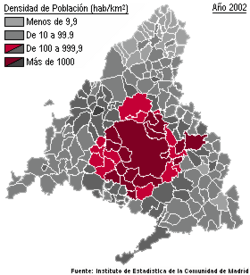Móstoles
| Móstoles | |||
|---|---|---|---|
| Municipality | |||
|
Church of the Assumption, Móstoles' oldest building | |||
| |||
 Móstoles Location in Spain | |||
| Coordinates: 40°20′0″N 3°52′0″W / 40.33333°N 3.86667°WCoordinates: 40°20′0″N 3°52′0″W / 40.33333°N 3.86667°W | |||
| Country |
| ||
| Region |
| ||
| Comarca | Madrid metropolitan area | ||
| Government | |||
| • Mayor | David Lucas (PSOE) | ||
| Area | |||
| • Total | 45.36 km2 (17.51 sq mi) | ||
| Elevation | 620 m (2,030 ft) | ||
| Population (2009) | |||
| • Total | 206,478 | ||
| • Density | 4,600/km2 (12,000/sq mi) | ||
| Demonym(s) | Mostoleños, Mostolenses, Mostoleros | ||
| Time zone | CET (UTC+1) | ||
| • Summer (DST) | CEST (UTC+2) | ||
| Postal code | 28930 - 28939 | ||
| Website | www.mostoles.es | ||
Móstoles (Spanish pronunciation: [ˈmos.to.les]) is the second-largest city in population belonging to the autonomous community of Madrid. It is located 18 kilometres southwest from central Madrid. Móstoles was for a long time only a small village, but expanded rapidly in the twentieth century.
To some extent it is a dormitory suburb of Madrid, but it is also home to several polígonos (industrial estates). The city also hosts the main campus of the Universidad Rey Juan Carlos.
Area and population
Mostoles has about 206.015 residents, Mostoles is located in the Community of Madrid, near the city of Madrid. After Madrid itself, it is the municipality with most residents of the Community of Madrid.
History
Móstoles became famous on May 2, 1808, when, although it was only a small village, one of its two mayors, Andrés Torrejón, declared war on France. This followed the Dos de Mayo Uprising the same day in Madrid which started the Peninsular War. The Monument to the Mayor (1908), located in Pradillo Square, was erected to commemorate the 100th anniversary of the historic events.
A resident of Móstoles, Manuela Malasaña, became a popular heroine of the uprising; a subway station and secondary school in Móstoles and a neighbourhood in Madrid are named after her.
Main sights
Historic buildings
Two of the most important monuments in Móstoles are churches; The medieval church of La Asunción has mudejar features. Its tower provides a home for storks. The Baroque hermitage of La Virgen de los Santos dates from the 17th century.
There is a monument which was erected to mark the one hundredth anniversary of the uprising.
Museums and galleries
Móstoles is the home of the Community of Madrid's modern art gallery, the Centro de Arte 2 de mayo. It was opened in 2008 to mark the two hundredth anniversary of the uprising after which is named.[1]
There is also a local history museum.
Transportation
Móstoles is connected to other suburbs and to central Madrid by:
- several major freeways (A-5 (Madrid-Badajoz-Lisbon), M-50) and toll highways (R-5).
- local and regional bus lines
- the Metrosur line (line 12, Madrid Metro)
- a commuter train line (line C-5 Cercanías Madrid) which has a terminus in Mostoles.
The railway line originally continued to Almorox, but the section beyond Mostoles was closed in the 1960s. Between Móstoles-El Soto railway station and Navalcarnero the track has been converted into a green route (via verde) for cyclists and walkers which crosses the river Guadarrama.[2] There is also a waymarked long distance walk to Guadelupe, Móstoles being on one of the traditional pilgrims' ways to that city.[3]
Notable people
- Iker Casillas, Spanish professional goalkeeper, plays for F.C. Porto and formerly Real Madrid
- Ruben de la Red, footballer
- Alberto Lora , Football
- Rafael Martínez, gymnast
- Christian Gàlvez Montero, actor and TV presenter
- Raul Arevalo, actor
- Rubén Belima, footballer
References
External links
| Wikimedia Commons has media related to Móstoles. |
.svg.png)

